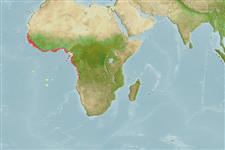>
Blenniiformes (Blennies) >
Blenniidae (Combtooth blennies) > Blenniinae
Etymology: Blennius: Greek,blenios = mucus (Ref. 45335).
Eponymy: John Roxborough Norman (1898–1944) was an English ichthyologist who started his working life as a bank clerk. [...] (Ref. 128868), visit book page.
More on author: Poll.
Environment: milieu / climate zone / depth range / distribution range
Ecologia
marino demersale; distribuzione batimetrica 20 - 200 m (Ref. 5298). Tropical
Eastern Atlantic: northern Mauritania to Angola.
Size / Peso / Age
Maturity: Lm ? range ? - ? cm
Max length : 11.0 cm SL maschio/sesso non determinato; (Ref. 5298)
Short description
Chiavi di identificazione | Morfologia | Morfometria
Spine dorsali (totale) : 11; Raggi dorsali molli (totale) : 13 - 14; Spine anali: 2; Raggi anali molli: 15 - 16; Vertebre: 31 - 32.
Adults are found on sand-mud bottoms (Ref. 5377). Oviparous. Eggs are demersal and adhesive (Ref. 205), and are attached to the substrate via a filamentous, adhesive pad or pedestal (Ref. 94114). Larvae are planktonic, often found in shallow, coastal waters (Ref. 94114).
Life cycle and mating behavior
Maturità | Riproduzione | Deposizione | Uova | Fecundity | Larve
Oviparous, distinct pairing (Ref. 205).
Bath, H., 1990. Blenniidae. p. 905-915. In J.C. Quero, J.C. Hureau, C. Karrer, A. Post and L. Saldanha (eds.) Check-list of the fishes of the eastern tropical Atlantic (CLOFETA). JNICT, Lisbon; SEI, Paris; and UNESCO, Paris. Vol. 2. (Ref. 5298)
IUCN Red List Status (Ref. 130435: Version 2024-1)
Threat to humans
Harmless
Human uses
Pesca: di nessun interesse
Strumenti
Special reports
Download XML
Fonti Internet
Estimates based on models
Preferred temperature (Ref.
123201): 15.8 - 20.7, mean 19.2 °C (based on 48 cells).
Phylogenetic diversity index (Ref.
82804): PD
50 = 0.7500 [Uniqueness, from 0.5 = low to 2.0 = high].
Bayesian length-weight: a=0.00575 (0.00253 - 0.01308), b=3.06 (2.86 - 3.26), in cm total length, based on LWR estimates for this (Sub)family-body shape (Ref.
93245).
Trophic level (Ref.
69278): 3.5 ±0.4 se; based on size and trophs of closest relatives
Resilienza (Ref.
120179): Alto, tempo minimo di raddoppiamento della popolazione meno di 15 mesi (Preliminary K or Fecundity.).
Fishing Vulnerability (Ref.
59153): Low vulnerability (10 of 100).
